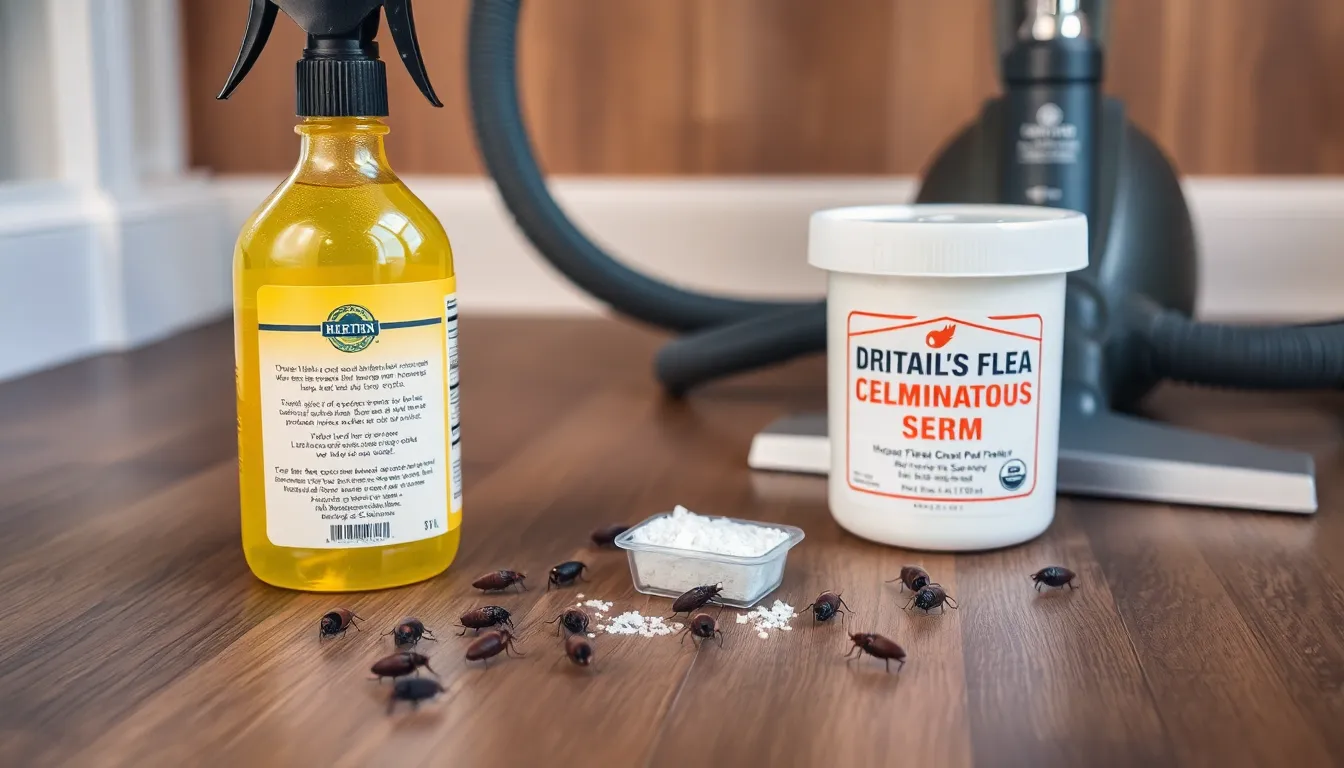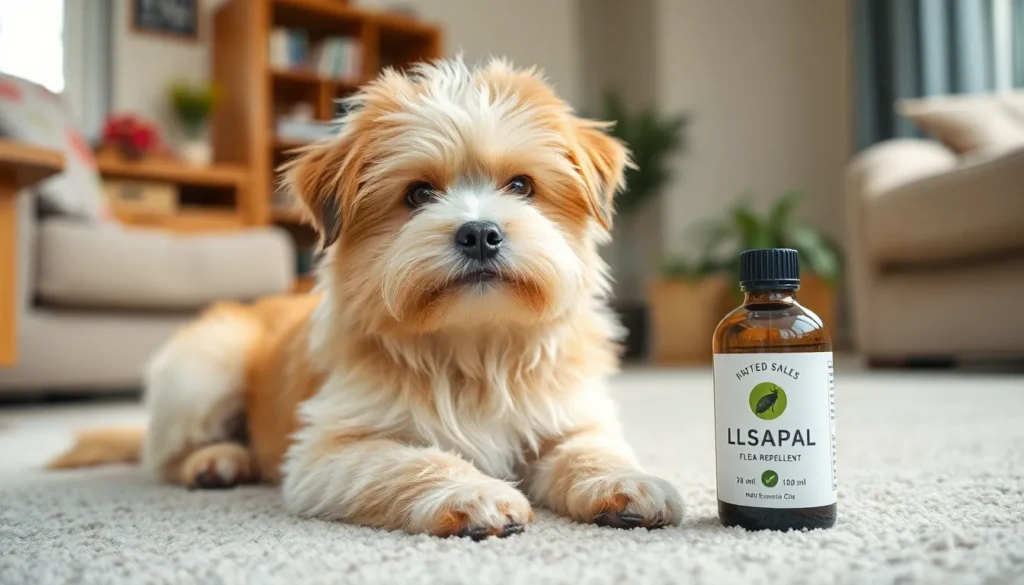Table of Contents
ToggleFleas are like uninvited guests at a party—annoying and hard to get rid of. These tiny pests can turn a cozy home into a scratching post for pets and humans alike. If you’re tired of playing hide-and-seek with these pesky critters, it’s time to take action. The good news? There are effective solutions that can zap those fleas on contact, sending them packing faster than a bad date.
Understanding Fleas and Their Life Cycle
Fleas are small, agile insects that thrive in various environments. Adult fleas measure 1/16 to 1/8 inch in length and possess a dark brown or black color. These pests can jump up to 150 times their body length, aiding their ability to move between hosts.
Fleas reproduce rapidly, with female fleas laying approximately 20 to 50 eggs each day. Eggs typically hatch within two to ten days, depending on environmental conditions such as temperature and humidity. The presence of a host provides additional warmth and nutrients that facilitate development.
Larvae emerge from the eggs as small, worm-like creatures. They begin feeding on organic debris, including flea feces, which is enriched with undigested blood. This stage lasts about five to eleven days before they pupate and become cocoons.
Pupae remain dormant for several weeks or even months. Their emergence depends on vibrations, heat, and carbon dioxide, which signal a potential host’s presence. Once conditions are favorable, adult fleas break free and seek hosts to feed upon.
Understanding this life cycle is crucial for effective flea control. As each stage presents different challenges, targeting the adult flea alone often isn’t sufficient. Comprehensive strategies require addressing all life stages to prevent re-infestation, ensuring lasting relief from these inevitable pests.
Effective Contact Killers for Fleas

Various options effectively eliminate fleas on contact, including chemical solutions and natural remedies.
Chemical Solutions
Insecticides are widely recognized for their immediate effectiveness. Pyrethrins and permethrin are two common ingredients that disrupt the nervous system of fleas, leading to quick death. Sprays with these active ingredients can provide instant results when applied directly to infested areas. Additionally, residual insecticides offer prolonged protection as they continue to kill fleas that come into contact with treated surfaces. Choosing appropriate formulations ensures they’re safe for pets and humans. Always follow application guidelines and safety precautions to minimize risks.
Natural Remedies
Diatomaceous earth stands out as a powerful natural solution. It dehydrates fleas upon contact, effectively breaking down their exoskeletons. Essential oils, such as lavender and cedarwood, also act as natural deterrents against fleas. These oils may repel fleas and even cause direct harm when applied in concentrated forms. Vacuuming regularly and washing pet bedding with hot water can create an inhospitable environment for fleas. Implementing these remedies can significantly reduce flea populations and promote a healthier living space.
Application Methods
Effective flea control requires using the right application methods to ensure immediate contact kills. Utilizing various options can help manage infestations effectively.
Sprays and Solutions
Insecticide sprays offer quick elimination of fleas on contact. Products containing pyrethrins or permethrin disrupt the nervous system of fleas, resulting in rapid deaths. For effective use, apply these sprays directly on infested areas, including carpets, rugs, and pet bedding. Ensuring pets are away during application is crucial. Residual sprays continue to kill fleas that wander into treated spaces, offering ongoing protection. Always check for pet safety before use, as certain formulations may contain harmful chemicals.
Flea Collars
Flea collars provide a convenient solution for long-lasting protection. These collars release active ingredients that repel and kill fleas upon contact. Available options include those containing organophosphates or natural oils. Properly fitting the collar around the pet’s neck ensures optimal effectiveness. Flea collars can also serve as complementary measures alongside other treatments. Regular inspection of the collar for wear and effectiveness is necessary, as worn collars lose potency.
Safety Considerations
Consideration for safety is crucial when using flea control products. Effective strategies must prioritize the well-being of both pets and humans.
For Pets
Pets’ safety remains a top priority during flea treatment. Chemical insecticides can irritate their skin or cause other health issues. Ensure that products labeled safe for pets are used. Natural options like diatomaceous earth may reduce exposure to harmful chemicals. It’s important to apply treatments in well-ventilated areas and keep pets away until surfaces are dry. Regularly inspect flea collars for any discomfort or adverse reactions. Always follow the manufacturer’s instructions to prevent accidents and maintain pet health.
For Humans
Human safety also takes precedence during flea control. Proper ventilation is essential when applying insecticides to avoid inhalation of harmful vapors. Avoid contact with treated surfaces until any residue has dried completely. Some chemicals may trigger allergic reactions or respiratory issues, so use personal protective equipment like gloves and masks when applying. Children should remain in a separate area while treatments take place. Always store products in original containers, out of reach of kids and pets, to prevent accidental ingestion. Following these guidelines helps ensure a safe environment for everyone involved.
Possible Limitations
Contact killers for fleas can face several limitations. Chemical insecticides, while effective, may pose risks to pets and humans. Certain individuals might experience allergic reactions, necessitating caution during application. Residual insecticides offer ongoing protection, yet some may not eliminate fleas that have already established in hard-to-reach areas.
Natural remedies present their own challenges. Diatomaceous earth, though useful, requires significant effort to apply evenly. Essential oils are often less potent than synthetic insecticides, making them insufficient for severe infestations. Effectiveness can vary based on the severity of the flea problem and individual responses to treatment.
Application methods also have constraints. Insecticide sprays can miss spots if not applied thoroughly. Flea collars depend on proper fitting to function effectively, and even then, they may only protect the area around the neck. Each method may need supplemental approaches to achieve comprehensive flea control.
Safety measures further complicate flea treatments. Pets must remain away from treated areas until surfaces dry, which can be challenging for active animals. Ensuring good ventilation is crucial for humans during application. Children tend to wander, increasing the risk of exposure to harmful chemicals if proper precautions aren’t taken.
Limited options are available for managing flea infestations. Understanding these limitations is vital for effective pest control. Adapting strategies based on the environment and current flea pressures can enhance success against these persistent pests.
Fleas can be a persistent nuisance but effective solutions are available to eliminate them on contact. By utilizing chemical insecticides or natural remedies like diatomaceous earth and essential oils, homeowners can tackle these pests swiftly. It’s essential to apply these treatments correctly and safely to protect both pets and family members.
Regular maintenance through vacuuming and washing bedding can further reduce flea populations, creating an inhospitable environment for these unwanted guests. Adapting strategies based on specific situations and understanding the limitations of various methods can enhance the success of flea control efforts. With the right approach, lasting relief from fleas is achievable.







